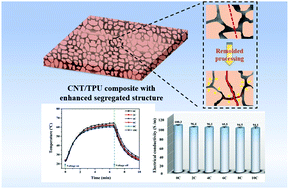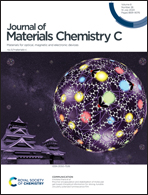A reliable and highly conductive carbon nanotube/thermoplastic polyurethane composite with an enhanced segregated structure for electrically driven heater applications†
Abstract
A stretchable carbon nanotube (CNT)/thermoplastic polyurethane (TPU) composite with an enhanced segregated structure was developed for use as an electrically driven heater. The segregated conductive networks can be repaired after multiple processing cycles, endowing the CNT/TPU composite with highly reliable electrical heating performance. The steady-state maximum temperature (TMAX) of the composite maintains a high retention of 95.2% even after the tenth cycle of processing, while the TMAX value for the CNT/TPU composite with a segregated structure suffers a 68.3% decrease after the second cycle of processing. Moreover, the enhanced segregated structure composite (ESSC) exhibits a tensile strength of 23.8 MPa and an elongation at break of 419.9%, which are almost doubled in comparison to the segregated structure composite (SSC); also, it meets the requirements for practical application as an electrically driven heater (EDH). The ESSC is capable of accommodating repeated heating and a large amount of strain and bending in a completely reversible fashion, thereby proving outstanding durability. This was proven by its application as a wearable electrical heater for personal heating management. This ESSC can facilitate an electrically driven heater with segregated networks for application in integrated flexible devices.



 Please wait while we load your content...
Please wait while we load your content...